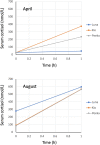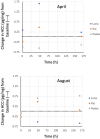Cortisol levels in blood and hair of unanesthetized grizzly bears (Ursus arctos) following intravenous cosyntropin injection
- PMID: 33978314
- PMCID: PMC8464257
- DOI: 10.1002/vms3.523
Cortisol levels in blood and hair of unanesthetized grizzly bears (Ursus arctos) following intravenous cosyntropin injection
Abstract
Hair cortisol concentration (HCC) is being used increasingly to evaluate long-term stress in many mammalian species. Most of the cortisol is assumed to passively diffuse from circulating blood into hair follicles and gradually accumulate in growing hair. However, our research with free-ranging grizzly bears (Ursus arctos) suggests HCC increases significantly within several hours following capture, a time too brief to be explained by this mechanism alone. In this study with captive grizzly bears, we sought to determine if a brief spike in blood cortisol concentration, thus mimicking a single stressful event, would cause an increase in HCC over a 7-day period. To do this, we administered a single intravenous dose (5 μg/kg) of cosyntropin to three captive unanaesthetised adult female grizzly bears on two occasions, during April when hair growth was arrested and during August when hair was growing. In both trials, the cosyntropin caused a two-fold or greater increase in serum cortisol levels within 1 hr but did not appear to influence HCC at 1, 48, and 168 hr following cosyntropin administration. We conclude the cosyntropin-induced cortisol spike was likely insignificant when compared to the adrenocortical response that occurs in free-ranging bears when captured. We suggest further study with a larger sample of captive bears to evaluate the combined effects of anaesthesia and multiple doses of cosyntropin administered over several hours would better simulate the adrenocortical response of free-ranging grizzly bears during capture.
Keywords: Ursus arctos; cosyntropin challenge; grizzly bear; hair cortisol concentration (HCC); serum cortisol concentration.
© 2021 The Authors Veterinary Medicine and Science Published by John Wiley & Sons Ltd.
Figures



Similar articles
-
Spatial analysis of factors influencing long-term stress in the grizzly bear (Ursus arctos) population of Alberta, Canada.PLoS One. 2013 Dec 27;8(12):e83768. doi: 10.1371/journal.pone.0083768. eCollection 2013. PLoS One. 2013. PMID: 24386273 Free PMC article.
-
INVESTIGATION OF SARCOCYSTIS SPP. INFECTION IN FREE-RANGING AMERICAN BLACK BEARS (URSUS AMERICANUS) AND GRIZZLY BEARS (URSUS ARCTOS HORRIBILIS) IN BRITISH COLUMBIA, CANADA.J Wildl Dis. 2021 Oct 1;57(4):856-864. doi: 10.7589/JWD-D-20-00225. J Wildl Dis. 2021. PMID: 34516653
-
Immobilization of grizzly bears (Ursus arctos) with dexmedetomidine, tiletamine, and zolazepam.J Wildl Dis. 2014 Jan;50(1):74-83. doi: 10.7589/2012-11-273. Epub 2013 Oct 25. J Wildl Dis. 2014. PMID: 24171564
-
Comparison of methanol and isopropanol as wash solvents for determination of hair cortisol concentration in grizzly bears and polar bears.MethodsX. 2017 Jan 30;4:68-75. doi: 10.1016/j.mex.2017.01.004. eCollection 2017. MethodsX. 2017. PMID: 28203534 Free PMC article.
-
EPIDEMIOLOGIC AND PUBLIC HEALTH SIGNIFICANCE OF TOXOPLASMA GONDII INFECTIONS IN BEARS (URSUS SPP.): A 50 YEAR REVIEW INCLUDING RECENT GENETIC EVIDENCE.J Parasitol. 2021 May 1;107(3):519-528. doi: 10.1645/21-16. J Parasitol. 2021. PMID: 34167147 Review.
Cited by
-
Evaluation of physiological stress in free-ranging bears: current knowledge and future directions.Biol Rev Camb Philos Soc. 2023 Feb;98(1):168-190. doi: 10.1111/brv.12902. Epub 2022 Sep 29. Biol Rev Camb Philos Soc. 2023. PMID: 36176191 Free PMC article. Review.
-
Blood cortisol and faecal cortisol metabolite concentrations following an ACTH challenge in unanaesthetized brown bears (Ursus arctos).Conserv Physiol. 2025 Jan 15;13(1):coae093. doi: 10.1093/conphys/coae093. eCollection 2025. Conserv Physiol. 2025. PMID: 39816213 Free PMC article.
References
-
- Ashley, N. T., Barboza, P. S., Macbeth, B. J., Janz, D. M., Cattet, M. R. L., Booth, R. K., & Wasser, S. K. (2011). Glucocorticosteroid concentrations in feces and hair of captive caribou and reindeer following adrenocorticotropic hormone challenge. General and Comparative Endocrinology, 172, 382–391. 10.1016/j.ygcen.2011.03.029 - DOI - PubMed
-
- Bechshøft, T. Ø., Sonne, C., Rigét, F. F., Letcher, R. J., Novak, M. A., Henchey, E., Meyer, J. S., Eulaers, I., Jaspers, V. L. B., Covaci, A., & Dietz, R. (2013). Polar bear stress hormone cortisol fluctuates with the North Atlantic Oscillation climate index. Polar Biology, 36, 1525–1529. 10.1007/s00300-013-1364-y - DOI
-
- Bodenner, D. L., Medhi, M., Evans, W. J., Sullivan, D. H., Liu, H., & Lambert, C. P. (2005). Effects of megestrol acetate on pituitary function and end‐organ hormone secretion: A post hoc analysis of serum samples from a 12‐week study in healthy older men. American Journal of Geriatric Pharmacotherapy, 3, 160–167. 10.1016/S1543-5946(05)80022-4 - DOI - PubMed
-
- Carlitz, E. H. D., Kirschbaum, C., Stalder, T., & van Schaik, C. P. (2014). Hair as a long‐term retrospective cortisol calendar in orang‐utans (Pongo spp.): New perspectives for stress monitoring in captive management and conservation. General and Comparative Endocrinology, 195, 151–156. 10.1016/j.ygcen.2013.11.002 - DOI - PubMed
Publication types
MeSH terms
Substances
LinkOut - more resources
Full Text Sources
Other Literature Sources
Miscellaneous

